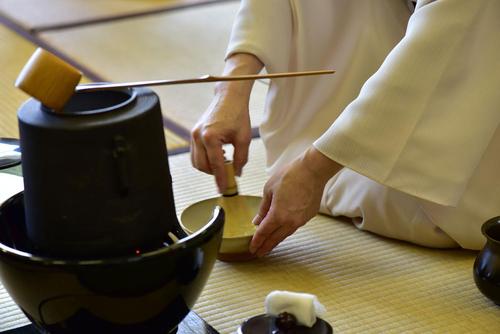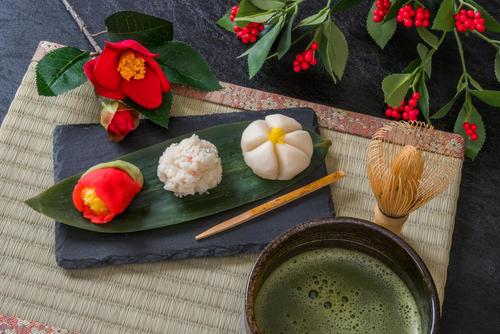The tea ceremony allows you to calm your mind and enjoy the taste and aroma of matcha and the atmosphere.
Its profound charm has attracted the attention of not only Japanese people but also people from overseas. The secret to its popularity is that the tea ceremony is not just about drinking tea, but is packed with many Japanese elements such as the spirit of hospitality, the beauty of tea utensils, and traditional etiquette.
"But tea ceremony seems kind of difficult..."
Many people probably feel the same way, so in this article we will introduce the history and etiquette of the tea ceremony, as well as the spirit of hospitality as taught by Sen no Rikyu.
What is the tea ceremony, a representative form of Japanese culture?

First, we will explain the overview and history of the tea ceremony.
Serving tea to guests in the traditional style
The tea ceremony is the act of preparing matcha tea and serving it to guests according to established traditional methods. Powdered matcha and hot water are placed in a tea bowl and stirred with a bamboo chasen (chasen).
It is not just about enjoying tea, but also incorporates all sorts of artistic elements, such as the etiquette of how to entertain guests, the spaces such as the garden and tea room, the tea utensils and other crafts, kaiseki cuisine and Japanese sweets, making it an especially popular part of Japanese culture.
History of the Tea Ceremony
It is said that tea first spread to Japan during the Kamakura period, when a monk named Eisai brought tea back to Japan from the Song Dynasty in China.
During the Muromachi period, the monk Murata Juko adopted Zen spirituality and started the "wabicha" style of tea ceremony, which featured small, simple tea rooms and a calm atmosphere. It was the famous tea master Sen no Rikyu who developed this into the prototype of the tea ceremony as a part of Japanese culture today.
Tea ceremony etiquette

The most difficult thing about the tea ceremony is probably the etiquette.
Sure, there are a few rules, but once you get the hang of it and get used to it, none of it is difficult.
Here we will explain how to sit in a tea room, how to make and drink tea, and how to enjoy tea sweets.
How to sit in a tea room
The guest of honor sits first near the host, followed by the second guest, third guest, and finally the attendant.
The guest of honor interacts with the host and manages the tea ceremony. The attendant, also known as the lowest seat, supports the tea ceremony by clearing away the tea utensils that have been passed around.
Both of these important roles require extensive experience and knowledge of tea. For this reason, the host selects the two people in advance.
If you are not familiar with tea ceremonies, it is safe to sit somewhere in the middle, other than the first or last seats.
How to prepare and drink tea
・How to make tea
To prepare, sift the matcha to prevent lumps. Boil soft water and cool it to about 80°C.
First, put 1-2g of matcha into a tea bowl using a tea scoop, then pour in 60-70cc of hot water using a ladle. Hold the tea bowl with one hand and stir well using the tea whisk.
<Glossary>
Chashaku (tea scoop): A tool used to scoop matcha into a tea bowl
Ladle: A tool used to scoop hot water
Chasen (tea whisk): A tool used to prepare matcha tea
The way the chasen is moved varies depending on the school. In Urasenke, the chasen is moved with a snap of the wrist to create a fine, creamy foam, while in Omotesenke, the chasen is moved gently to make the tea without creating too much foam.
・How to drink tea
First, take the tea bowl with your right hand and place it in front of you. Then greet the host by saying, "Thank you for the tea ceremony," and take the tea bowl.
To avoid touching the front of the tea bowl, which may have a design, to your mouth, rotate the bowl clockwise twice in your left hand. Drink the tea in three or four sips, making a final sip to indicate that you've finished. Then, wipe the rim of the teacup with your finger and wipe your fingers on a piece of paper.
Finally, rotate the tea bowl counterclockwise twice in your left hand, return it to the front, and place it where it was served.
This time we have introduced the Urasenke style, but there are some differences in the way tea is drunk depending on the school.
How to eat tea sweets
Tea sweets are eaten before drinking tea to enhance the flavor of matcha.
When the host offers you sweets, bow and take one portion for each guest on a kaishi (small paper). Then say "Osakini" (thank you for your time) to the next guest before eating.
Place the tea sweets together with the kaishi in the palm of your hand, and if they are large, cut them up with a toothpick, or if they are buns, break them up with your hands, so that you can finish eating them before the tea is served.
Be sure to prepare some kaishi paper and Kuromoji or other sweet toothpicks in advance.
Learn the spirit of hospitality in the tea ceremony

"Omotenashi" can now be considered a universal language, but in the tea ceremony, the teachings of Sen no Rikyu, who laid the foundation for it, are strongly reflected.
The Seven Rules of Rikyu: The Spirit of Hospitality in the Tea Ceremony
We will introduce the seven teachings of the tea ceremony that Sen no Rikyu taught, which can be considered the spirit of hospitality.
"Seven Rules of Rikyu"
1. Make tea according to the guest's condition and feelings.
2. Place the charcoal so that the water boils (preparation should be done accurately and with care).
3. Stay cool in summer and warm in winter (Hospitality involves using tools and sweets to make the recipient feel comfortable)
4. Arrange flowers as they are in the wild (expressing the essence of flowers by utilizing their natural beauty and vitality)
5. Arrive early (be prepared and do everything with a relaxed mind)
6. Prepare for rain even when it doesn't rain (Be prepared for the other person so that you can respond flexibly in any situation)
7. Treat your guests with respect (Hosts and guests, and guests among themselves, should be considerate and respectful of each other)
This teaching exemplifies the essence of the spirit of hospitality, which is to be considerate of others, pay attention to even the smallest details, and do everything possible to ensure everything is perfect.
Things to keep in mind when entertaining guests with the tea ceremony
"Ichigo Ichie" expresses the spirit of the tea ceremony, which means "treating the tea ceremony as a once-in-a-lifetime opportunity, doing our best to provide hospitality, and cherishing the moment for both parties."
When it comes to hospitality, it's important to pay attention to the small details, such as decorating with seasonal flowers and using incense and aromas to create a comfortable atmosphere for your guests. If you're nervous, you won't be able to enjoy the tea, so it's important to keep the atmosphere relaxed and enjoyable, with appropriate conversation.
Tea is not served immediately after the customer takes their seat, but after they have had a moment to catch their breath and calm down.
In order for you to enjoy a relaxed time, it is important to pay close attention to details so that you are not rushed.
Furthermore, enjoying tea is not just about the aroma and taste, but also about appreciating the beauty of the bowl. To ensure that the customer can fully enjoy the bowl, the pattern of the tea bowl should be facing forward.
summary
Japanese tea ceremony has continued to develop and be passed down since the Muromachi period, and is now popular worldwide. Its appeal lies not only in the taste of matcha, but also in the Zen spirituality of experiencing wabi-sabi in a simple tea room, and in the "spirit of hospitality that is based on consideration of the guest and that is done to the utmost," as preached by Sen no Rikyu.
The idea of a tea ceremony may seem intimidating at first, but we recommend starting by making tea for yourself at home and savoring it slowly in your favorite tea bowl.
Why not prepare some seasonal flowers and tea and sweets and spend some relaxing time together?
Mini lesson corner
Learn about Japan and the Japanese language!
"What is the difference between Senchado and Matcha tea ceremony in 90 seconds?"
This article has been partially re-edited by KARUTA from an article originally published on "Nihongo Biyori."
Any unauthorized reproduction or use of the contents, text, images, illustrations, etc. of this website is strictly prohibited.
